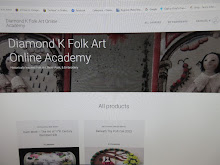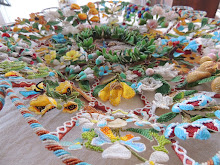At the kind request from the Izannah Walker Doll group to post on the differences of these early fasteners, I have taken a few snaps of some early hook & eye fasteners on different gowns here at the Museum. I am by no means an expert, but I think I will be able to help you all descirn the different between an early, and modern type of hook & eye closings.
I know metal hooks have been used for closing clothing since the 1300s....used with crochet loops instead of hard wire ones....but I dont start to see them commonly used as fasteners until the late 1820s. The picture above and below, is a c1835 girls dress, for a petit 7 or 8 yr old. Early hooks & eyes were made of copper, then most commonly brass until the 1850s....twards the 1860s I have seen blue'd steel, blackened steel in the 1870s and to the 1890s, brass again as well as the black, which were advertised to be rustproof. Early examples do not rust at all, but they do tarnish~ the brass ones turn green and can discolor the fabric around them, so it is always advisable to lay a buffered acid free tissue between the hook/eyes and the dress fabric when storing.

These brass hooks are original to this mid 1830 silk girls dress. The hook part itself can be found to be hammered nearly flat on the very edge (these are NOT)....those tend to be found more twards the 1860s and later.
Looking down, if you enlarge the picture, you will be able to notice the main difference between early hooks, and modern ones. What do you think it is???

 Looking across, you can see that no longer is the back of the hook FLAT, but it has grown a bump. This bump was supposed to help keep the hook from popping loose. I have seen dresses that close with the hook & eye alternating, which really makes for a tight closure
Looking across, you can see that no longer is the back of the hook FLAT, but it has grown a bump. This bump was supposed to help keep the hook from popping loose. I have seen dresses that close with the hook & eye alternating, which really makes for a tight closure This picture shows, tho a little blurry, the different between an early and modern one~ the hook on the left is modern, the black one on the right, c1860(see how it is hammered flat on the edge?) If you look in the center of the modern hook on the left, you will see and added wire there, making the count 3, instead of 2....
This picture shows, tho a little blurry, the different between an early and modern one~ the hook on the left is modern, the black one on the right, c1860(see how it is hammered flat on the edge?) If you look in the center of the modern hook on the left, you will see and added wire there, making the count 3, instead of 2.... That 3rd wire, (the modern ones are still just made from a single wire, they are just wrapped differently) is what makes the 'safety catch' on the back of the hook. Some of them have such a high bump, that they really are quite difficult to get unhooked, and when hooked into the eye, or loop, make a little 'snap' noise. You can see the early hook has an entirely FLAT back.
That 3rd wire, (the modern ones are still just made from a single wire, they are just wrapped differently) is what makes the 'safety catch' on the back of the hook. Some of them have such a high bump, that they really are quite difficult to get unhooked, and when hooked into the eye, or loop, make a little 'snap' noise. You can see the early hook has an entirely FLAT back.
























6 comments:
Rechael, your posts are always so informative.
You really pay attention don' t you? So you remember the fox, huh.
I have worked a bit on my unfinished sampler. Have you done any work on your quilt? Come on, tell the truth.
Carole
Hi Carole!
YES! I HAVE been steadily working on my quilt~ every day, and matter of fact, I am SIX days ahead of sched! I have completed 124 sashings, and have just FOUR left~ I cant believe it! Four more days, and I will have a complete, huge Baltimore Album top. THANKYOU for asking!
So have you seen sly fox lately? They really are pretty, even if they do eat my chickens
xoxoxo rachael
I love looking at your blog. Thank you so much for sharing :)
Angie
Thankyou Angie for visiting, and taking the time to drop me a line~ I appreciate it and am glad you enjoy it!
rachael
I always so enjoy your blog when searches turn it up! In this case, I very much appreciate these detailed images of period hooks and eyes.
One minor comment - the stitched loops are not crochet, but buttonholed bars. A large, loose stitch or two is taken in the fabric, and then buttonhole stitch is worked around this large stitch from one end to the other.
It's the same technique that's used for needlework fillings. Here is a very clear explanation of how they're worked:
http://handembroiderynetwork.blogspot.com/2009/10/stitch-day-buttonhole-bars.html
Thankyou for stopping by Jessamyn~ you are very correct~ my Mother always called them crochet loops, so I dont even think about it now when I accidentally call them that!They are indeed a series of tight button hole stitches over a thread~ most of the time doubled. They are made just as detached button hole stitch is in embroidery. oxoxxo rachael
Post a Comment